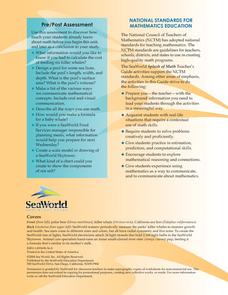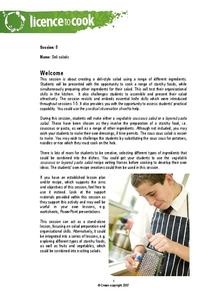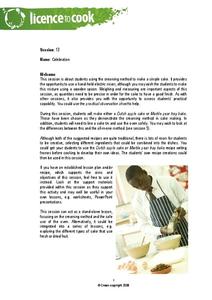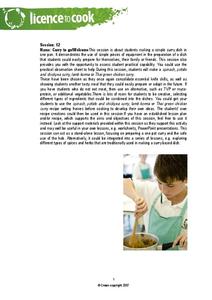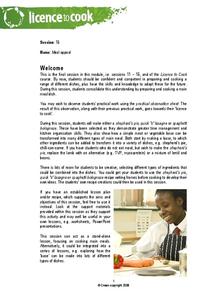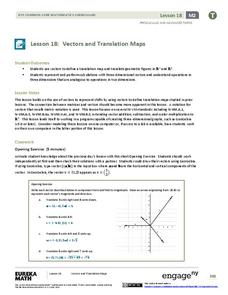J. Paul Getty Trust
Shaping Ideas: Symbolism in Sculpture—Lesson 3
The final session in a sequential, three-lesson sculpture study designed by the education staff of the J. Paul Getty Museum in Los Angeles has class members using the criterial they developed to critique each others' symbolic sculptures.
Curated OER
Area and Perimeter Floor Plan
Using Google SketchUp, learners draw a model of their bedroom. They begin by measuring the dimensions of their bedroom, inputting this information into the software program, and calculating perimeter and area. This is an interesting and...
Curated OER
How to Locate and Evaluate Information, Part I - Online Catalog
Using the online catalog, researchers locate and record on a citation template specific sources for their research paper. A library specialist models searching strategies while the teacher introduces the research paper process. Daily...
Curated OER
Modeling: Having Kittens
Cats can't add, but they do multiply! Determine the number of descendants of a single cat given specific facts about cats and kittens. The lesson focuses on developing strategies for problem solving using both individual and group work....
Sea World
Splash of Math
How can kids use math to learn about marine life? Combine math skills with science lessons in a resource featuring activities about life in the sea. Kids graph and calculate data, solve complex word problems, measure geometric shapes,...
Food a Fact of Life
Soup-er!
Is there anything better than hot soup on a cold day? Kids prepare either vegetable chowder or minestrone soup in an activity that features the use of the stove top.
Food a Fact of Life
Top Toastie
Croque-monsieur? How about pizza toast? Fire up the grill and show your young chefs how to prepare and enjoy these tasty offerings. The 13-page packet includes a rationale for the instructional activity, grocery and...
Food a Fact of Life
Brilliant Baking
Young chefs are introduced to the use of the oven with an activity that asks them or whip up a batch of fruity flapjacks or tropical granola bars. Yum!
Food a Fact of Life
Getting to Grips
Fruit fusion or dippy divers, anyone? Here's a delicious way to introduce young cooks to aspects of safe food handling and the use of food handling tools. Groups create fruits and/or vegetable salads to share with the class.
Food a Fact of Life
Batch Bake
Sweet and savory muffins, yum. Young bakers bake batches of these tasty treats to demonstrate their competence in the kitchen. A real recipe for success.
Food a Fact of Life
Pasta Mania
The timing of preparing a roux sauce to accompany either a tuna and broccoli pasta bake or macaroni and cheese is the challenge young cooks face in this foods lesson.
Food a Fact of Life
Feel the Rub
Cheesy scones, rock cakes, and scone-based pizza are featured in this exercise that focuses on shaping rubbed-in dough. The 13-page packet includes step-by-step directions, shopping and equipment lists, images, and worksheets.
Food a Fact of Life
Deli Salads
The challenge in this foods lesson is staying organized in the kitchen while preparing a vegetable couscous salad or a layered pasta salad. Young cooks work in teams to prepare these nutritious meals.
Food a Fact of Life
Celebration
Mastering the creaming method in cake making is featured in a foods activity that asks class members to prepare a Dutch apple cake or a marble pear tray bake. A delicious way to celebrate.
Food a Fact of Life
Stir-Fry Crazy!
Sizzling stir-fry. Fajitas. Yum. Stove-top cooking is the focus of this activity designed for young cooks.
Food a Fact of Life
Curry to Go!
Spinach, potato, and chickpea curry, lamb korma, Thai green chicken curry. Class groups mix up a variety of dishes featuring this versatile spice.
Food a Fact of Life
Meal Appeal
To demonstrate their mastery of time management and kitchen organization skills, groups prepare either a shepherd's pie, lasagne, or spaghetti bolognese.
EngageNY
Vectors and Translation Maps
Discover the connection between vectors and translations. Through the lesson, learners see the strong relationship between vectors, matrices, and translations. Their inquiries begin in the two-dimensional plane and then progress to the...
EngageNY
Modeling with Quadratic Functions (part 2)
How many points are needed to define a unique parabola? Individuals work with data to answer this question. Ultimately, they determine the quadratic model when given three points. The concept is applied to data from a dropped...
EngageNY
Modeling with Quadratic Functions (part 1)
Relevance is key! The resource applies quadratic modeling by incorporating application of physics and business. Pupils work through scenarios of projectile motion and revenue/profit relationships. By using the key features of the graph,...
EngageNY
Solving Problems by Finding Equivalent Ratios
Combine total quantities and equivalent ratios in problem solving. The fifth instructional activity in a series of 29 presents problems that can be solved using equivalent ratios. Pupils use part-to-part ratios and either sums or...
Mathematics Assessment Project
Representing Quadratic Functions Graphically
Sometimes being different is an advantage. An engaging activity has scholars match cards with quadratic functions in various forms. Along the way, they learn about how each form highlights key features of quadratic functions.
Mathematics Assessment Project
Designing 3d Products: Candy Cartons
Wouldn't it be great to work in a candy factory? Learners get their chance as they first design a carton for a candy that meets certain requirements. They then examine and analyze nets and explanations in sample student responses.
Mathematics Assessment Project
Solving Quadratic Equations
Scholars first complete an individual assignment using a quadratic equation to model the movement of a bus around a corner. Learners then discuss their solutions with classmates and analyze the provided sample responses.




